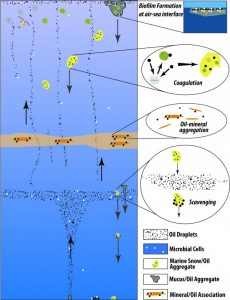Study Develops Numerical Model for Marine Oil Snow Aggregate Formation and Sinking
– NOVEMBER 13, 2018
Researchers developed the first detailed numerical model for predicting the conditions under which marine oil snow aggregates form and the amount of oil they transport to the ocean floor. The team validated the model using observational data collected during the Deepwater Horizon incident and found that it reproduced the aggregate size spectra reasonably well. They identified several factors that affected model accuracy, in particular its sensitivity to calculations for particle fractal dimensions, stickiness, and disaggregation. The model can help inform response and planning activities associated with oil spills in marine environments.
The researchers published their findings in Journal of Geophysical Research: Oceans: Numerical modeling of the interactions of oil, marine snow, and riverine sediments in the ocean.
Marine snow is made up of naturally-present particles and, when oil is present, these particles can interact with oil and form aggregates known as marine-oil-snow. Under the right circumstances, marine-oil-snow can form in large numbers and sink, causing what are called Marine Oil Snow Sedimentation and Flocculant Accumulation (MOSSFA) events.
“Computer simulations that predict the fate of oil in the oceans generally do not include the formation and fate of marine oil snow,” explained study author Adrian Burd. “However, these can be a significant process for depositing oil onto the seafloor. For example, during the Deepwater Horizon oil spill, as much as 20 – 30% of the oil spilled is thought to have ended up on the seafloor. Our model can help to fill that gap and give us a better prediction for the amounts of oil that end up on beaches, or that end up on the seafloor.”
The researchers based their model on the Stochastic Lagrangian Aggregate Model for Sinking Particles (SLAMS) that simulates marine particle coagulation and disaggregation. They modified the model to account for oil, river sediment particles, aggregate disintegration, seawater properties, stratification effects on aggregate settling velocities, aggregate fractal dimensions, and aggregate stickiness.
“This study built on a novel computational methodology, which was the result of a collaboration between mathematical modelers, experimentalists, and field scientists. The new methodology allowed us to calculate the formation of aggregates containing different amounts of oil, algae, sediment grains, and other particles. This allowed us to calculate the rates of the formation of aggregates with different compositions and sizes and predict the rate at which they carried oil to the seafloor,” said Burd.
The team plans to improve estimations for factors that affected model accuracy and to incorporate other factors such as dispersant use into the model’s predictions.
Data are publicly available through the Gulf of Mexico Research Initiative Information and Data Cooperative (GRIIDC) at doi:10.7266/N73R0R75 and doi:10.7266/N779437K.
The study’s authors are Anusha L. Dissanayake, Adrian B. Burd, Kendra L. Daly, Simone Francis, and Uta Passow.
By Nilde Maggie Dannreuther and Stephanie Ellis. Contact maggied@ngi.msstate.edu with questions or comments.
************
This research was made possible in part by a grant from the Gulf of Mexico Research Initiative (GoMRI) to the University of Georgia, the University of California Santa Barbara, and the University of South Florida for their project Oil-Marine Snow-Mineral Aggregate Interactions and Sedimentation during the 2010 Deepwater Horizon Oil Spill.
The Gulf of Mexico Research Initiative (GoMRI) is a 10-year independent research program established to study the effect, and the potential associated impact, of hydrocarbon releases on the environment and public health, as well as to develop improved spill mitigation, oil detection, characterization and remediation technologies. An independent and academic 20-member Research Board makes the funding and research direction decisions to ensure the intellectual quality, effectiveness and academic independence of the GoMRI research. All research data, findings and publications will be made publicly available. The program was established through a $500 million financial commitment from BP. For more information, visit https://gulfresearchinitiative.org/.
© Copyright 2010-2018 Gulf of Mexico Research Initiative (GoMRI) – All Rights Reserved. Redistribution is encouraged with acknowledgement to the Gulf of Mexico Research Initiative (GoMRI). Please credit images and/or videos as done in each article. Questions? Contact web-content editor Nilde “Maggie” Dannreuther, Northern Gulf Institute, Mississippi State University (maggied@ngi.msstate.edu).






